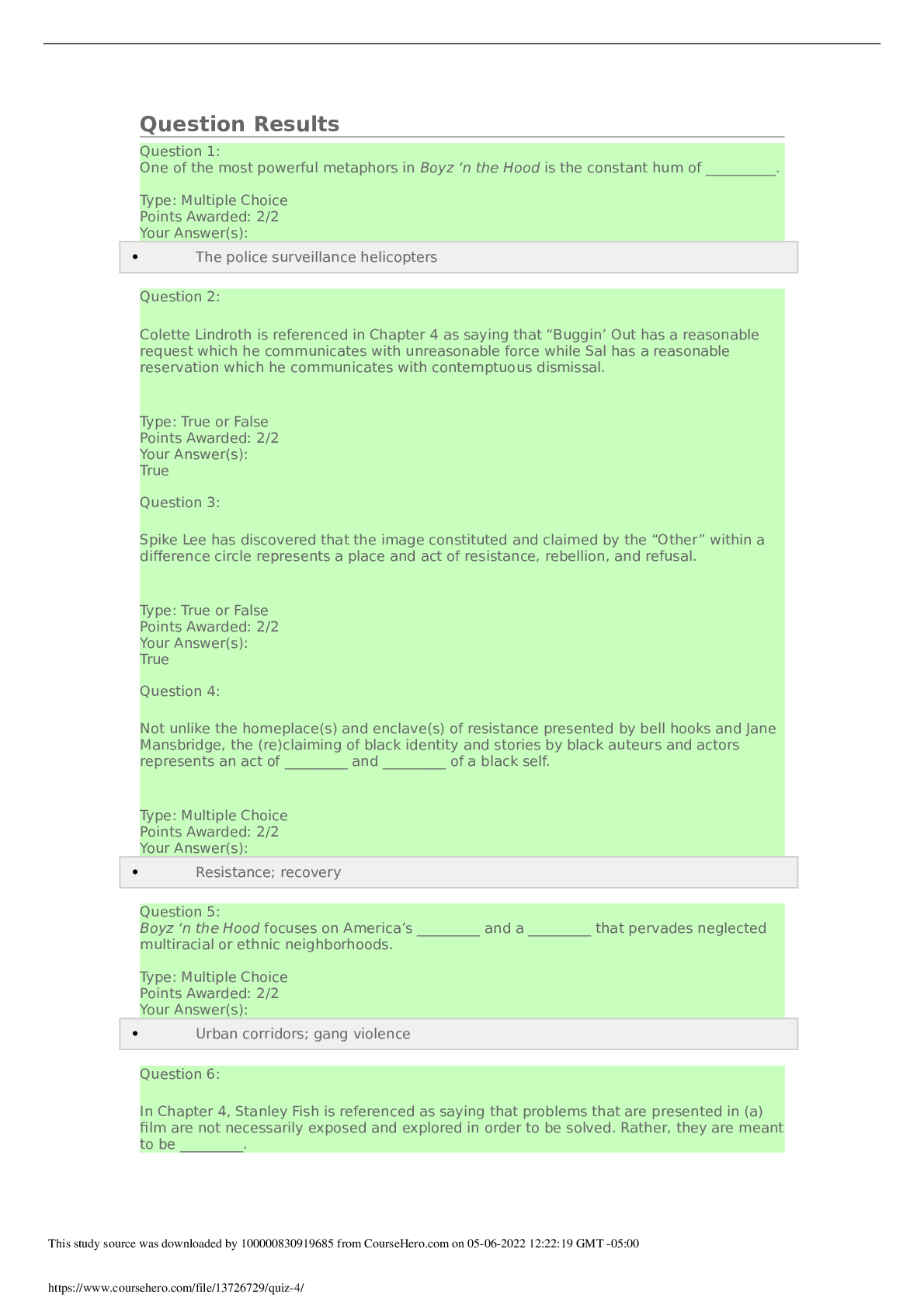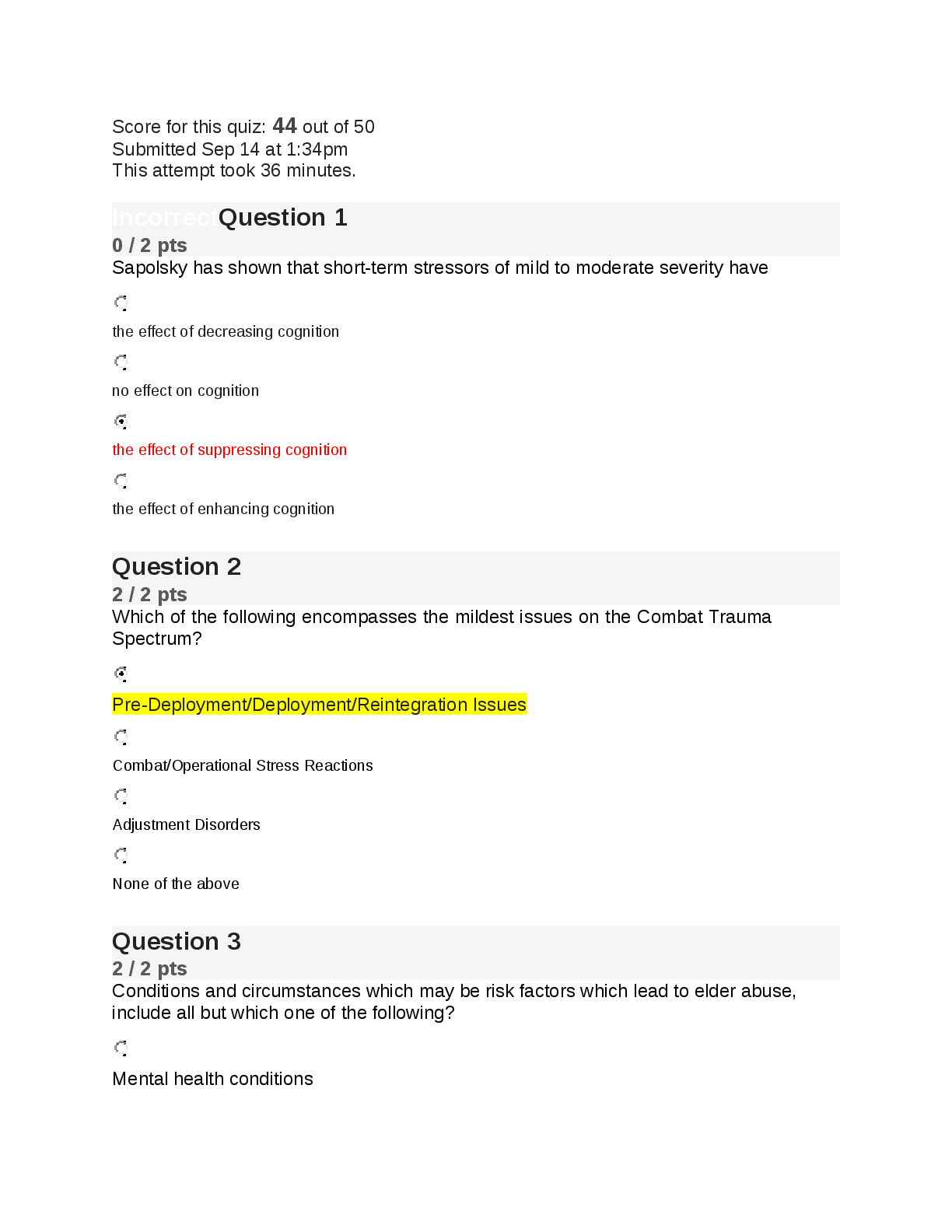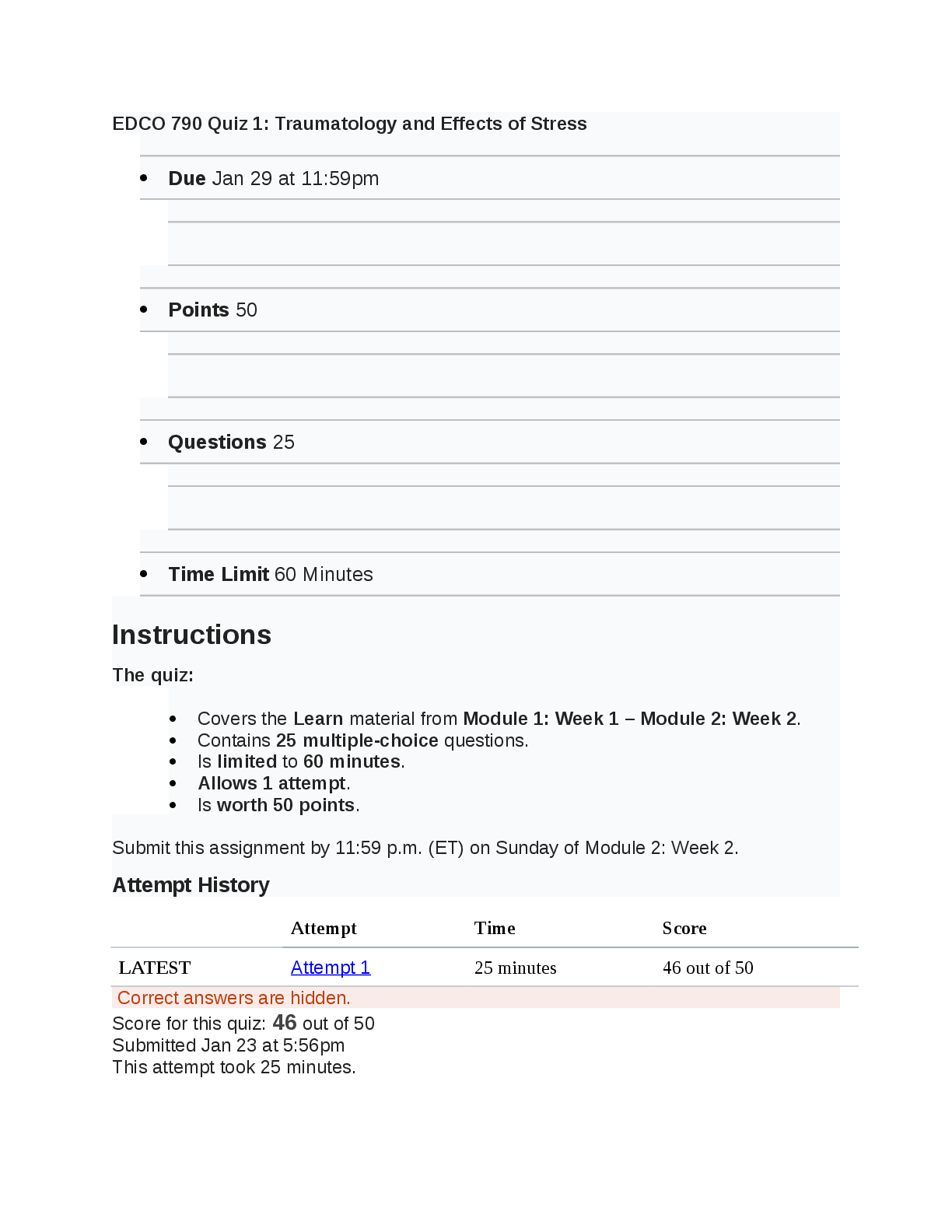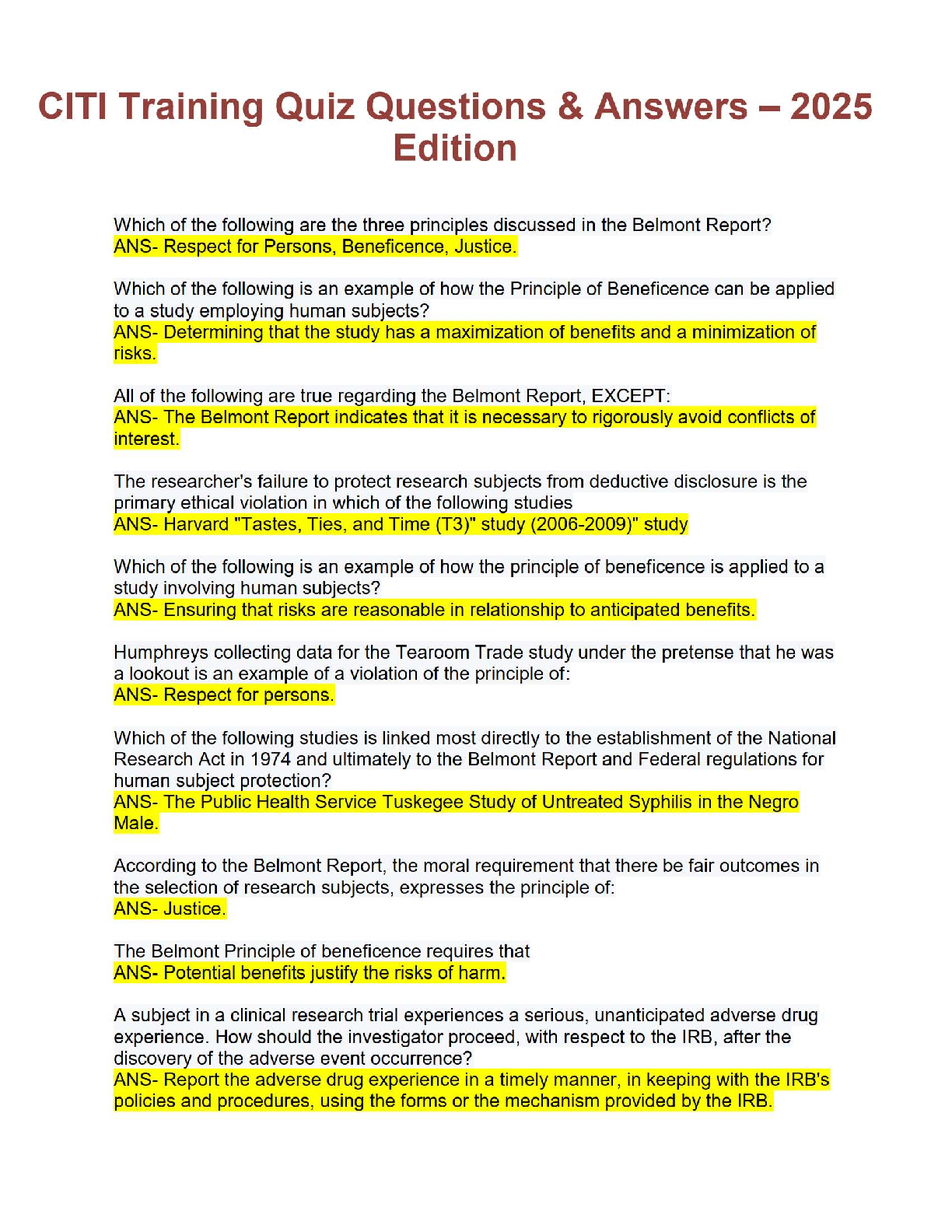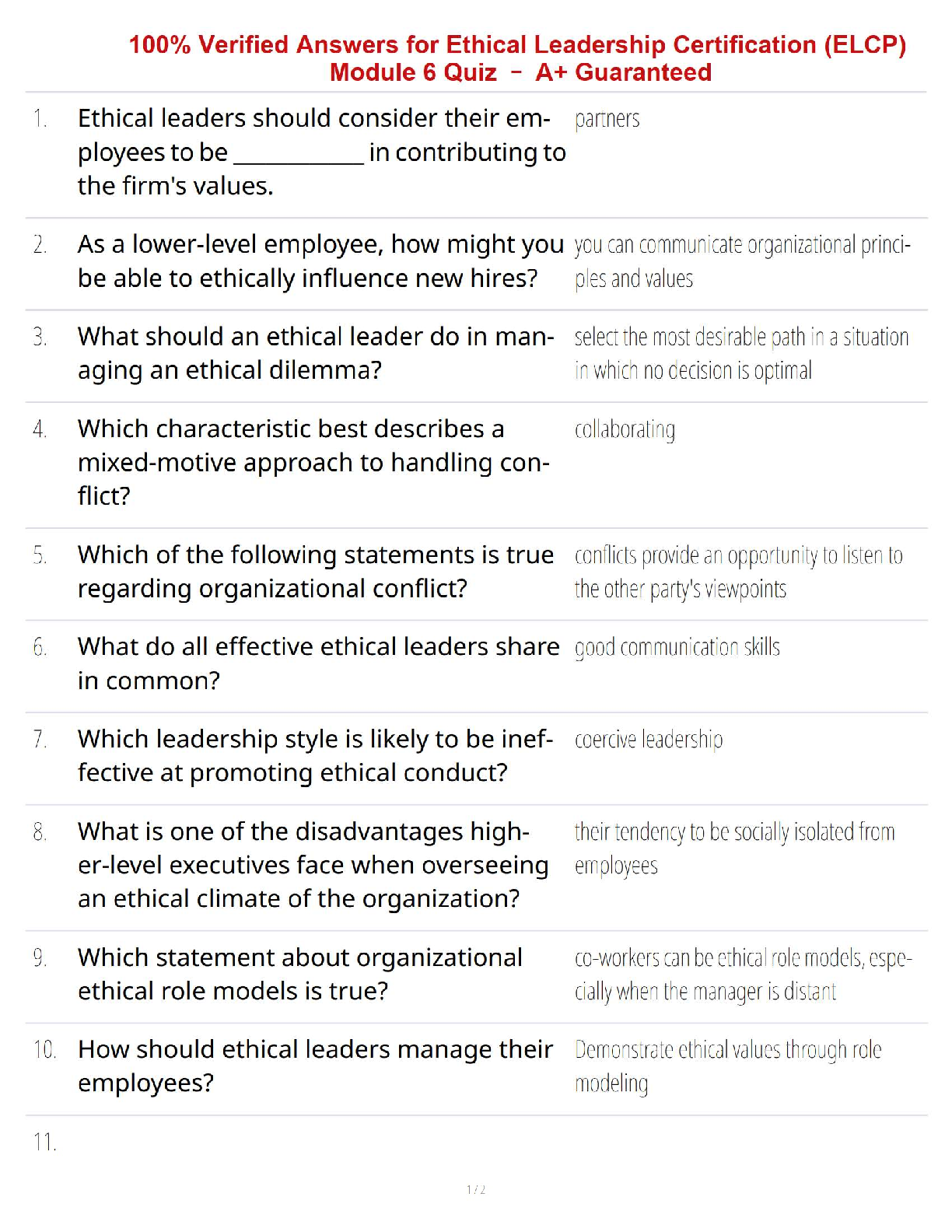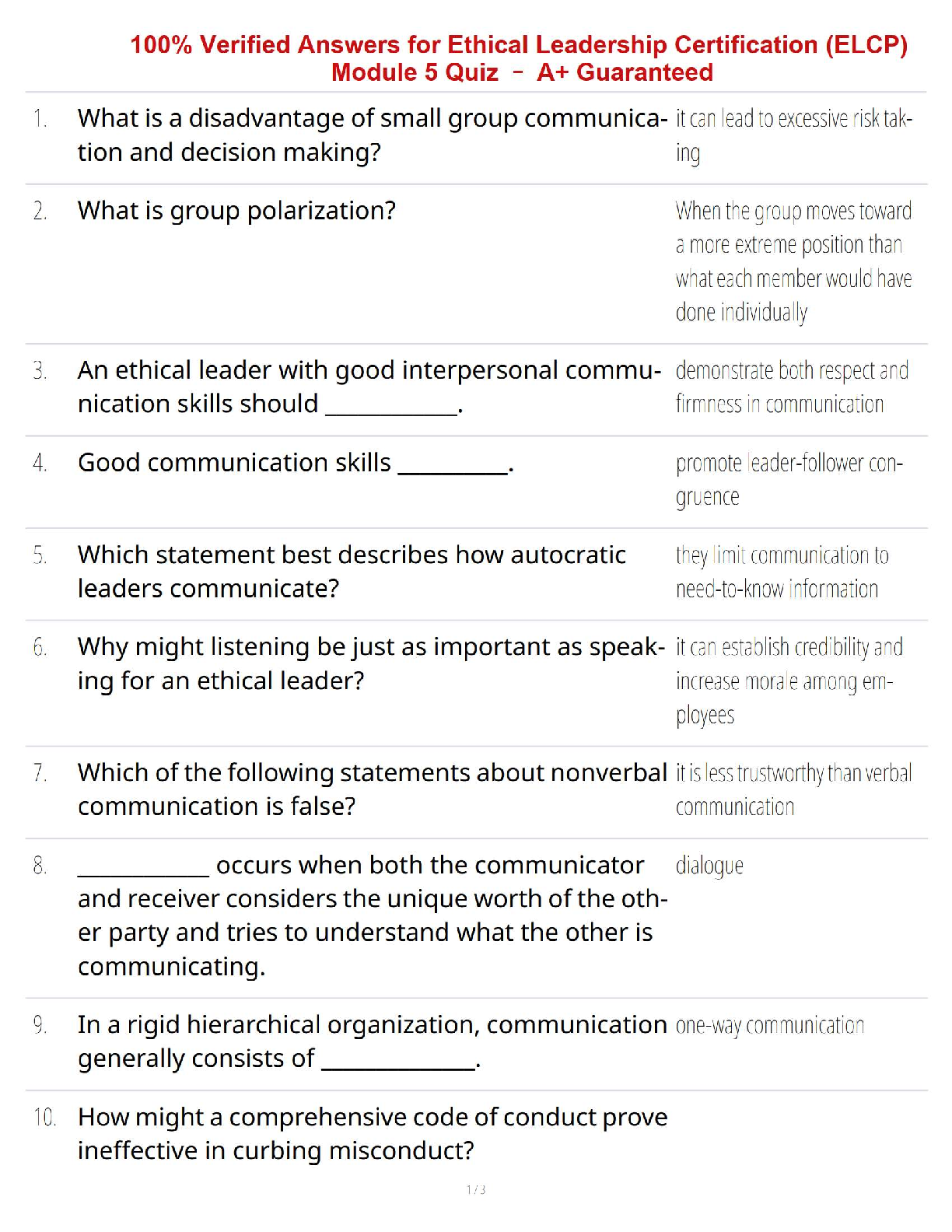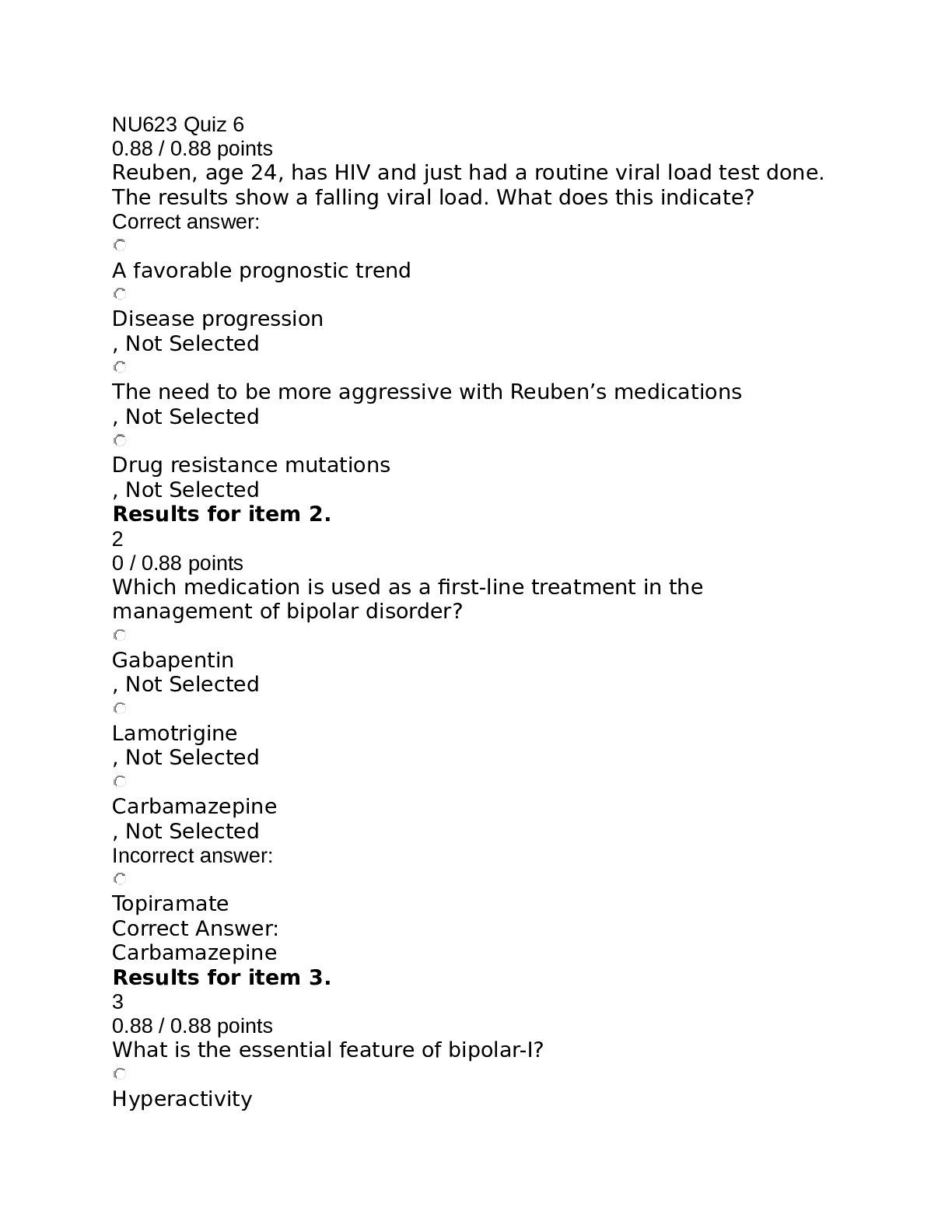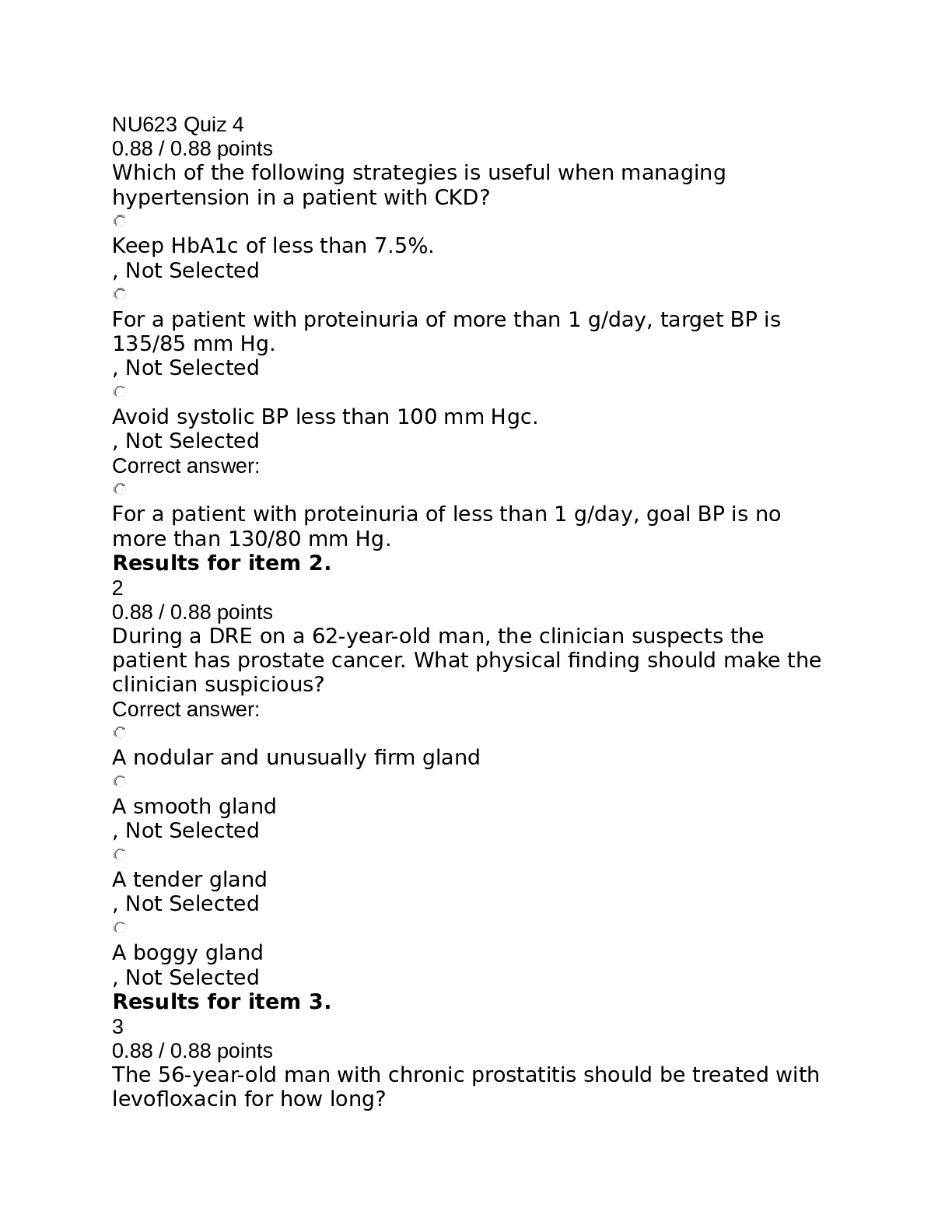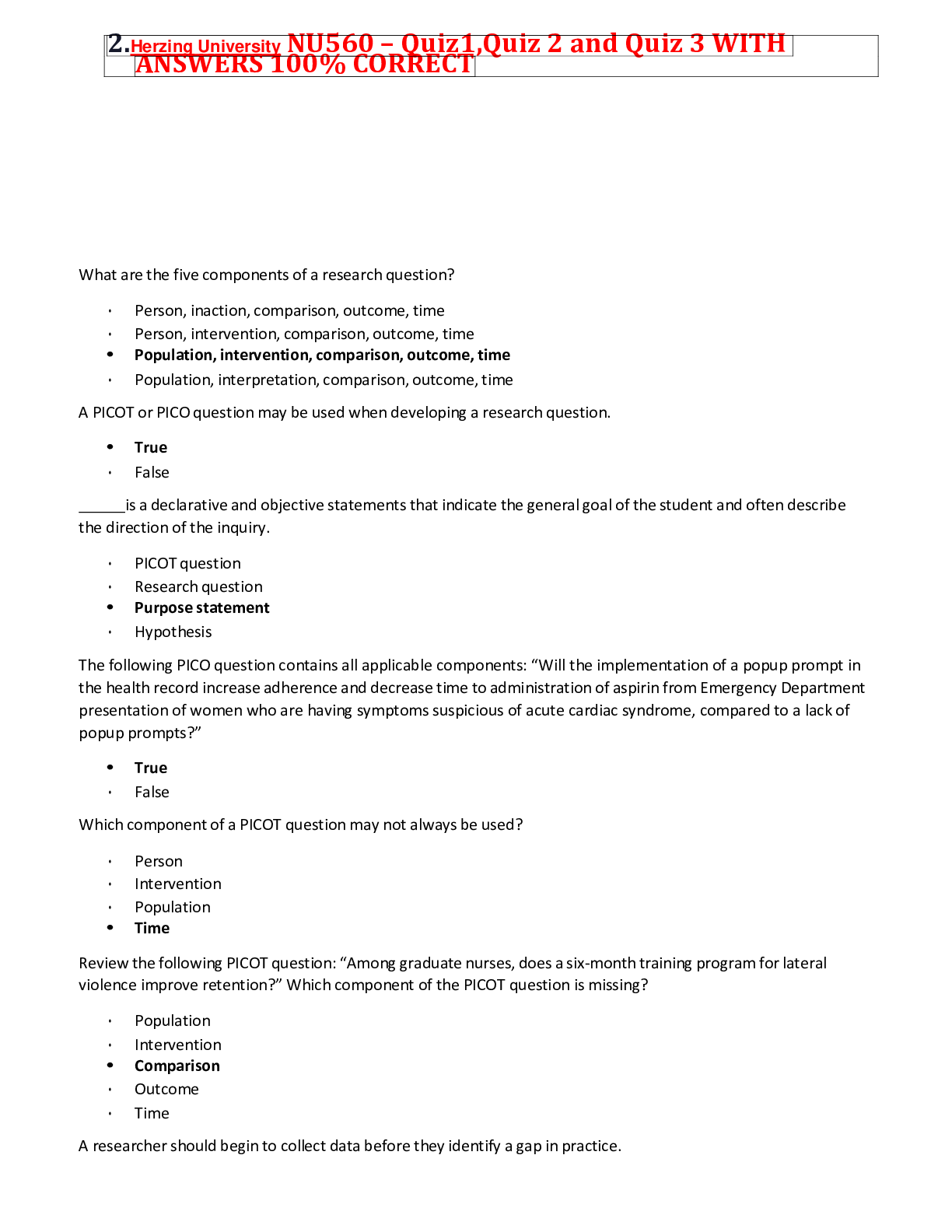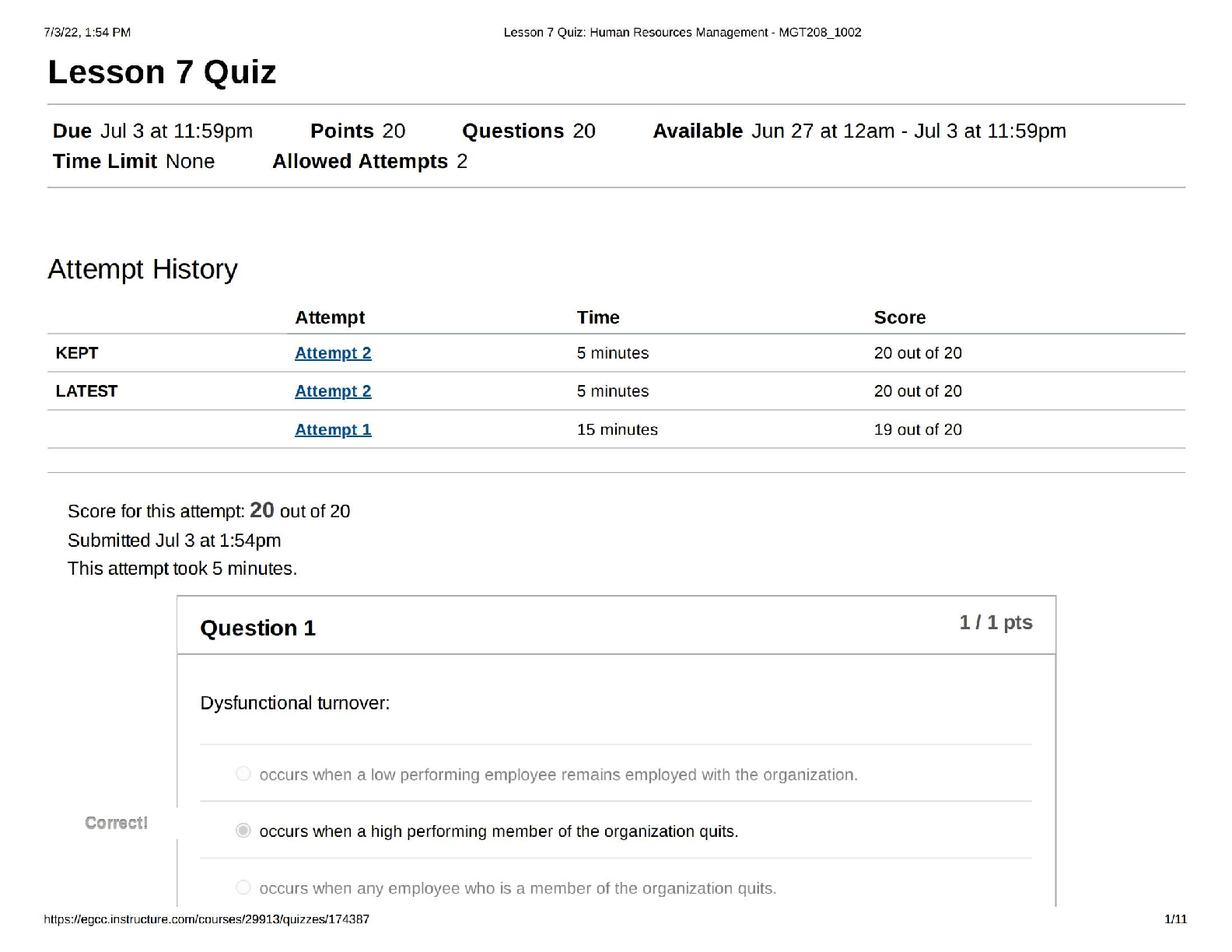*NURSING > Quiz > NURS 6551 Womens Health_ All Week 1 to Week 11 Quizzes Compilation. Walden University. (All)
NURS 6551 Womens Health_ All Week 1 to Week 11 Quizzes Compilation. Walden University.
Document Content and Description Below
Walden University – Week 1,2,3,4,5,6,7,8,9,10,11 NURS 6551 Womens Health Quiz Week 1,2,3,4,5,6,7,8,9,10,11 Walden University – Week 1 NURS 6551 Womens Health Quiz Week 1 1.) Gender is root ... ed in _______and shaped by____________? c.) biology, environment and experience 2.) What area of injury prevention is a focus of the USPSTF’s guidelines for counseling all healthy, asymptomatic women? NOT all of above. . . . . I think Falls is answer 3.) What had been a significant problem in medical research well into the 1990’s? B.) the lack of representation of women in research trials 4.) why is acknowledging the oppression of women more difficult within Western societies? d.) affluence and increased opportunities mask oppression 5.) Which factor bears most on women’s health care today? B.) Women’s status and position in society 6.) according to WHO the presence of a disease state: NOT prompt medical attention. . . 7.) How many states does the Ranner scale use to stage sexual maturity? B.) 5 8.) What is the leading preventable cause of death across all populations in the US? B.) tobacco 9.) what is the USPSTF recommendation regarding firearms? C.) remove from home or store unloaded in locked compartments 10.) IN what way does a model of care based on a feminist perspective constrast sharply with a biomedical model? NOT it emphasizes womens rights as the answer Walden University – Week 2 NURS 6551 Womens Health Quiz Week 2 Approximately how many working American adult women older than 18 smoke cigarettes? a. 20% b. 10% c. 5% d. 30% In respect to an evidentiary examination: a. The patient may not withhold consent if the clinician is a mandated reporter. b. The clinician is required to strictly follow local agency protocols, no others. c. The time frame within which it must take place depends on local standards. d. Maintaining the chain of custody of all evidence collected is recommended, not required. There is no one legal definition of rape, which means: a. Clinicians must learn their own state’s definitions and statutes. b. It is easier to monitor the incidence of sexual violence in the nation. c. It may be considered a social problem, not a public health problem. d. Measuring risk and identifying protective measures is a simple task. If a patient has not reported a sexual assault to law enforcement, all of the following clinician actions are important except: a. Asking if reporting is something she wants to consider b. Discussing any fears or concerns that she may have about reporting c. Explaining that only some forced sexual contacts are reportable crimes d. Telling her that women who report do better psychologically than those who do not What is the current (2006) recommendation by the CDC regarding HIV testing? a. Test all patients who report risk behaviors associated with HIV b. Test all patients unless they explicitly decline to be tested. c. Test all patients. d. Test only those patients who ask to be tested. What is the screening recommendation by the American College of Obstetricians and Gynecologists for intimate partner violence (IPV)? a. Routinely ask all women direct, specific questions about abuse. Refer to community-based services when identified. b. There is insufficient evidence to recommend for or against routine screening. c. No screening recommendation. d. Remain alert for signs of family violence at every patient encounter. Which of the following are screening tests for type 2 diabetes mellitus? a. Fasting plasma glucose b. Two-hour post-load plasma glucose c. Hemoglobin A1C d. All of the above The USPSTF assigns a certainty level to assess the net benefit of a preventive service based on: a. The nature of the overall evidence available b. The cost-effectiveness of a service c. Known health outcomes d. Select studies in a limited primary care population The most effective means of obtaining the history of abuse is to use a communication model that: a. Avoids having the patient’s children present during the discussion b. Signals someone is interested and that the woman is not alone c. Emphasizes the belief that violence is not acceptable, no matter what the batterer might have said to the patient d. Allows the patient to talk without interruption and with time to relate, emphasize, and repeat her full story In the GTPAL system for recording pregnancy history, the “T” stands for: a. Term births b. Terminal pregnancies c. Total number of pregnancies d. Type of birth (spontaneous, assisted, or cesarean) Walden University – Week 3 NURS 6551 Womens Health Quiz Week 3 What is the danger of giving estrogen replacement therapy (ERT) to menopausal women with an intact uterus? a. A higher risk of heart disease b. An increased likelihood of blood clots c. An increased likelihood of osteoporosis d. A higher risk of endometrial cancer Women who report experiencing the most severe symptoms of PMS tend to be: a. In their late 40s b. In their early 20s c. In their late teens d. In their late 30s What term refers to the period from about 7 to 10 days before menstrual flow begins until the first or second day of menstrual flow? a. Amenorrhea b. Premenstrual c. Dysmenorrhea d. Perimenstrual Tubal sterilization for women who have completed their families is highly effective, but there are disadvantages such as: a. Women are less likely to use condoms or return for health services. b. There is a decreased risk of ovarian cancer and pelvic inflammatory disease. c. There is a high likelihood of complications and side effects. d. The surgery is not covered by insurance. How is secondary dysmenorrhea defined? a. Absence of menstruation due to an underlying pathology b. Painful menstruation in the absence of pathology c. An underlying pathology causing pain symptoms during menstrual flow d. Painful menstruation that occurs after the age of 35 Which of the following is one of the key criteria for a diagnosis of PMS? a. The symptoms markedly interfere with occupational functioning. b. One of the symptoms is depressed mood, anxiety, or irritability. c. Exclusion of other diagnoses that may better explain the symptoms. d. The symptoms are confirmed by prospective daily ratings over at least two menstrual cycles. The methods of abortion used in the United States—in order, with the most common method listed first—are: a. Aspiration, medication, induction, surgical b. Medication, induction, aspiration, surgical c. Surgical, induction, medication, aspiration d. Induction, aspiration, surgical, medication Of the two intrauterine contraceptive devices currently available in the United States only one provides a local delivery of protestin. It is the: a. Combined contraceptive patch (Ortho Evra) b. Copper IUD (T380A, ParaGard) c. LNG-IUS (Mirena) d. Dalkon Shield What is one of the side effects of hormonal contraceptives? a. Reduction in ovarian cancer risk b. Increased menstrual blood loss c. Increased risk of endometrial cancer d. Heavier menstrual flow Which contraceptive methods have inherent failure rates? a. None b. Some c. All d. All except sterilization Walden University – Week 4 NURS 6551 Womens Health Quiz Week 4 1. Which of the following is a chronic lifelong infection? a. Herpes simplex virus b. Gonorrhea c. Syphilis d. Human papillomavirus 2. How does vaginosis differ from vaginitis? (The correct answer is NOT A) a. It must be treated with metronidazole b. The discharge does not contain white blood cells c. The discharge does not have an odor d. It causes itching and/or burning 3. How do systematic antiviral drugs treat genital herpes? a. The can control the symptoms b. They can reduce the frequency of recurrences after discontinuation. c. They can prevent transmission to sexual partners. d. They can protect secondary infections. 4. What is the most common symptoms of bacterial vaginosis? a. Vaginal itching and/or burning. b. Cottage cheeselike discharge c. Fishy odor d. Yeasty odor 5. What is the most common symptom of vulvovaginal candidiasis? a. Fishy odor b. Fever c. Thin, grayish-white discharge d. Vulvar pruritis 6. What is the major source of normal vaginal secretions? a. Bartholin’s glands b. Apocrine glands c. Sebaceous glands d. Cervical mucosa 7. Approximately how many Americans will contract one or more sexually transmitted infections during their lifetime? a. 50% b. 25% c. 40% d. 60% 8. What can bacterial vaginosis lead to? a. Vulvovaginal candidiasis b. Pelvic inflammatory disease c. Toxic shock syndrome d. Trichomoniasis 9. Approximately what percentage of women with bacterial vaginosis are asymptomatic? (Correct answer is NOT C). a. 25% b. 40% c. 75% d. 50% 10. The American College of Nurse-Midwives recently revised its definition and scope of midwifery to include treatment of: a. Male partners for sexually transmitted infections b. Children up through the age of five c. Male partners for cancer screening d. Children up through the age of two Walden University – Week 5 NURS 6551 Womens Health Quiz Week 5 1. What is a good first question to ask women who present with a concern about abnormal bleeding? a. What is a normal pattern for you? b. How long has this persisted? c. What was your last menstrual cycle like? d. How many times has this occurred? 2. In women of reproductive age, the most common cause of a bleeding pattern that is suddenly different is: a. An increase in estrogen b. A reaction to a change in eating or exercise habits c. Adrenal hyperplasia d. A complication of pregnancy 3. Lichen sclerosis is a benign, chronic, progressive disease of the skin in which the most common symptom is: a. Vulvar pruritis b. Vaginal discharge c. Postcoital bleeding d. Dysparenunia 4. What is a common vasomotor symptom of menopause? a. Blood clots b. Night sweats c. Osteoporosis d. Hysterectomy 5. Why is adenomyosis frequently underdiagnosed? a. It cannot be detected via an ultrasound b. It is almost always asymptomatic c. It is most common in adolescents d. It has similar symptoms to other pelvic pain conditions. 6. Approximately what percentage of patients with polycystic ovary syndrome (PCOS) are obese? a. 50% b. 25% c. 75% d. 40% 7. What is the term for the absence of menses for 3 to 6 months in a woman who has previously menstruated and is not pregnant, breastfeeding, or menopausal? a. Primary amenorrhea b. Initial dysmenorrhea c. Secondary amenorrhea d. Primary dysmenorrhea 8. What should be used for women whose hirsutism remains refractory after 6 months of combined oral contraceptive use? a. Antiandrogens b. Progestogens c. Metformin d. GnRH 9. A first-line recommended treatment for women with polycystic ovarian syndrome (PCOS) is: a. Photoepilation b. Anabolic steroids c. Analgesics d. Combined oral contraceptives 10. Signs of endometrial or cervical cancer may present abnormal uterine bleeding, often as heavy, prolonged bleeding, or: a. Menometrorrhagia b. Amenorrhea c. Oligomenorrhea d. Polymenorrhea Walden University – Week 6 NURS 6551 Womens Health Quiz Week 6 1. Which of the following is a preventive measure for vulvar cancer? a. Avoiding exposure to HIV b. Not smoking c. There is no way to prevent it d. Colposcopy 2. The most common benign breast masses are: a. Galactoceles b. Hamartomas c. Fibroadenomas and cysts d. Lipomas and phyllodes tumors 3. The infertility evaluation is an opportune time to suggest health promotion behaviors that may specifically improve fertility, including: a. Achieving a BMI in the range of 30 to 35, if the woman is under- or overweight b. Reducing alcohol consumption to about 4 drinks per week. c. Reducing caffeine consumption to no more than 350 per day d. None of the above. 4. What symptom is present in 80 to 90 percent of women with cervical cancer? a. Abnormal vaginal bleeding b. Abnormal vaginal discharge c. Pelvic pain d. Ectopic pregnancy 5. Which of the following is an ethical issue that is specifically associated with pre-implantation testing with ART? a. Ownership of frozen embryos after the couple has divorced. b. A surrogate deciding she does not want to relinquish the infant. c. Genetic engineering and the ability to reject embryos affected by inherited disorders d. The implantation of multiple embryos which can create high risk for the embryos and the woman. 6. A woman’s lifetime risk of being diagnosed with breast cancer is: a. 1 in 3 b. 1 in 8 c. 1 in 29 d. 1 in 233 7. The genetic counselor has a significant role in the care of women because BRCA1 and BRCA2 genetic mutations account for 5 to 10 percent of all _____ cancer cases. a. Breast b. Ovarian c. Uterine d. Pancreatic 8. The form of assisted reproductive technology that requires fertilization to occur within a patent fallopian tube, instead of a laboratory dish, is called: a. Intracytoplasmic sperm injection (ICSI) b. Gamete intrafallopian transfer (GIFT) c. Zygote intrafallopian transfer (ZIFT) d. In vitro fertilization (IVF) 9. Cyclic mastalgia: a. More likely causes unilateral, localized pain that is sharp or burning in nature b. Has an increased risk of occurrence in women whose diets are low in fat. c. Occurs most frequently in women who are 18 to 30 years old. d. Is caused by hormonal changes associated with menstruation. 10. All of the following diagnostic tests and procedures are now infrequently performed in clinical practice except: a. Hysterosalpingogram b. Sperm penetration assay c. The postcoital test (PCT) d. Endometrial biopsy (EMB) e. Walden University – Week 7 NURS 6551 Womens Health Quiz Week 7 1. What is the percentage of all unintended pregnancies in the United States? a. 5% b. 15% c. 25% d. 50% 2. What is the most typical schedule of prenatal care in the first 28 weeks of pregnancy? a. Visits scheduled every 2 weeks b. Visits scheduled every 3 weeks c. Visits scheduled every week d. Visits scheduled every 4 weeks 3. What step can a clinician take to learn more about any chemicals used in a woman’s workplace? a. Contact OSHA (Occupational Health and Safety Administration) b. Contact the woman’s workplace c. Ask the woman to obtain her workplace MSDs (material safety data sheet) d. Conduct research on the OSHA website 4. How can hormonal influences during pregnancy cause backache? a. They loosen ligaments and joints b. They increase fluid to the spinal cord. c. They cause muscles to swell. d. They increase nerve sensitivity. 5. A common prenatal care model in which women have their first visit with one provider and then subsequent visits in a group setting is called: a. HolisticBirthing b. Midwifery c. CenteringPregnancy d. PathologyCare 6. How are pregnancy-related DHA (docosahexaenoic acid) needs best met? a. By consuming 2 servings of fatty low-mercury-content fish per week b. By taking prenatal vitamin supplement c. By consuming 2 to 4 servings of fruit daily d. By consuming 3 to 4 servings of dairy products daily 7. Where does edema tend to occur in the pregnant woman’s body? a. Hands b. Face c. Feet d. Abdomen 8. When is round ligament pain most likely to occur in pregnant women? a. Between 6-8 weeks’ gestation b. Between 24-28 weeks’ gestation c. Between 10-12 weeks’ gestation d. Between 16-20 weeks’ gestation 9. What is a common cause of leg cramps during pregnancy? a. An imbalance of calcium and magnesium b. Dehydration c. An inability to sleep d. Poor nutrition 10. Qualitative urine testing for hCG (human chorionic gonadotropin) can be done reliably _____ days after implantation of the blastocyst (fertilized egg). (The answer is NOT C.) a. 0-7 days b. 7-9 days c. 9-14 days d. 14-24 days Walden University – Week 8 NURS 6551 Womens Health Quiz Week 8 QUESTION 1 Which of the following scenarios is suspicious for the development of neonatal jaundice with potential for kernicterus? a. A 7-day-old breastfed infant with yellowing of the sclera b. A 7-day-old infant with AB+ blood whose mother has B+ blood c. A 7-hour-old infant who is breastfed, is alert, and has normal skin tone d. A 7-hour-old infant who is Rh positive and whose mother is Rh negative 1 points Saved QUESTION 2 Which of the following statements regarding infants with PKU is true? a. They require special infant formulas. b. They are seriously ill in the newborn period. c. Breastfeeding is contraindicated. d. Aspartame (NutraSweet) is a preferred sugar substitute for these children. 1 points Saved QUESTION 3 Abdominal pain and vomiting are troublesome in children with type 1 diabetes because these symptoms can occur in which of the following dangerous conditions? a. Ketoacidosis b. Parasitic gastroenteritis c. Hyperglycemia d. Autoimmune response in the pancreas 1 points Saved QUESTION 4 A 2-year-old with sickle-cell anemia presents to your office with a fever of 103.4°F, lethargy, and malaise. The mother tells you she stopped giving the child the amoxicillin prescribed by his hematologist because she is concerned about antimicrobial resistance. Which of the following diagnoses should be considered in this scenario? a. Acute chest syndrome b. Pneumococcal bacteremia c. Vasocclusive crisis d. Hemarthrosis 1 points Saved QUESTION 5 Children and adolescents with acquired hypothyroidism often have: a. Decreased linear growth b. Third fontanelles c. Soft, silky hair d. Advanced bone age 1 points Saved QUESTION 6 Iron deficiency anemia is most common in what age group? a. 6 to 9 months b. 9 to 24 months c. 18 to 36 months d. 4 to 5 years 1 points Saved QUESTION 7 Which of the following is NOT a standard of care for children with sickle-cell anemia? a. Annual complete blood count (CBC) b. Bimonthly liver and kidney function testing c. Collaboration with a pediatric hematologist d. Routine wellness care with special attention to immunization status 1 points Saved QUESTION 8 Which of the following children is at risk for lead poisoning? a. A child who lives in a home with copper water pipes b. A child whose sibling has an elevated lead level c. A child who lives in public housing built in 1999 d. A child whose father is a hunter 1 points Saved QUESTION 9 Which of the following statements regarding galactosemia is true? a. The disease is X-linked. b. Infants with galactosemia are ill at birth. c. The disease is due to a buildup of an amino acid. d. Vomiting, seizures, and lethargy start in the second and third weeks of life. 1 points Saved QUESTION 10 A 14-month-old is diagnosed with iron deficiency secondary to poor iron intake. Her hemoglobin is 8.7 g/dl. You counsel regarding the sources of dietary iron. The most appropriate next step is: a. Give intramuscular ferrous sulfate. b. Administer oral ferrous sulfate 3–6 mg/kg divided three times daily. c. Measure Hgb again in 1 month after dietary changes. d. Refer for a hematology consult. 1 points Saved Walden University – Week 9 NURS 6551 Womens Health Quiz Week 9 1. What is the term for a postpartum disorder in which bacteria ascend from the lower genital tract and infect the uterus? a. Postpartum amenorrhea b. Postpartum endometritis c. Postpartum staphylococcus d. Postpartum lochia 2. About how many infants born to mothers colonized with Group B streptococcus will be colonized as well? a. 40% b. 25% c. 10% d. 50% 3. What is the term or stimulation of the uterus by an external agent to enhance uterine contractions after labor has started? a. Exteriorization b. Induction c. Augmentation d. Presentation 4. The onset of labor is indicated by regular uterine contractions and: a. Complete dilation of the cervix b. Change in the position of the fetus c. Rupture of the membranes d. Progressive cervical change 5. What should be addressed during the late postpartum maternal evaluation (weeks 2-6)? a. The healing of the mother b. The need for birth control information or supplies c. The birth plan of the mother d. The latching-on response of the infant 6. Exclusive breast milk feedings are ideal during the: a. First month of life b. First year of life c. First six months of life d. First three months of life 7. Which of the following is a predictor of impending preterm birth? a. Positive fetal fibronectin testing b. Cervical length less than 15 mm c. Meconium-stained amniotic fluid d. Cord prolapse 8. What is an indication of the second stage of labor? a. Complete dilation of the cervix b. Rupture of the membranes c. Emergence of the infant’s head d. Presence of bloody show 9. Without treatment shortly after birth, as many as 90 percent of infants born to hepatitis B-infection mothers will: a. Develop HIV b. Have cognitive difficulties c. Need blood transfusions d. Become infected 10. Postpartum depression occurs in about what percentage of women who give birth? a. 5-10% b. 25-30% c. 10-15% d. 1-5% Walden University – Week 10 NURS 6551 Womens Health Quiz Week 10 1. What should be considered in order to interpret the Mini-Mental State exam considering the diagnosis of Alzheimer’s disease? a. Education b. Family history of Alzheimer’s Disease c. Medications that include estrogen d. Past history of concussion 2. Which of the following statements does not support the diagnosis of Alzheimer’s disease? a. Crying every day b. Forgetting where she puts things c. Getting lost driving to the grocery store d. Lost ability to balance checkbook 3. Which of the following is not a risk factor for Alzheimer’s disease? a. Smoking b. Head injury c. Age d. History of hormonal contraception 4. The pharmacologic therapy of choice for migraines is from which class: a. Beta-adrenergic blockers b. Ergot alkaloid c. Nonsteroidal anti-inflammatory drugs d. Selective serotonin receptor agonists 5. Screening for hyperlipidemia is recommended to begin at what age for women with no risk factors? a. 35 b. 40 c. 45 d. 50 6. Chest pain associated with irritation of the myocardial nerve fibers (such as with angina pectoris or myocardial infarction) is due to an increase in: a. Blood glucose b. Lactic acid c. Serum magnesium d. Serum potassium 7. What is the definition of a primary headache? a. A headache that occurs only before and during menstruation b. A headache is caused by a preexisting condition c. A headache that is not a symptom of, or caused by, another condition d. A headache that is characterized by muscle tension 8. All of the following are associated with chest pain and representative of coronary artery disease except: a. Diaphoresis b. Jaw pain c. Pain with inspiration d. Shortness of breath 9. The most important part of the work-up to diagnose Alzheimer’s disease is: a. CT or MRI scan b. Mental status examination c. History of present illness d. Neurologic examination 10. The clinician is seeing a 48-year-old women for the first time. She is overweight and has a blood pressure of 120/92. She is on no medications and does not smoke or drink alcohol. Her family history is negative for heart disease. Her physical exam is unremarkable. The clinician should advise her as follows: a. Her blood pressure is high normal and does not require further follow-up at this time. b. She has prehypertension c. She has stage 1 hypertension d. She needs two additional blood pressure checks on two separate occasions. Walden University – Week 11 NURS 6551 Womens Health Quiz Week 11 1. Fever associated with pyelonephritis will usually resolve within how many hours of treatment with antibiotics? a. 24 hours b. 12 hours c. 72 hours d. 80 hours 2. What is the recommended interval target between urinations? a. 30-45 minutes b. 3-4 hours c. 1-2 hours d. 4-5 hours 3. Uncomplicated acute bacterial cystitis occurs in women who: a. Are pregnant b. Have no signs of upper tract infection c. Have a high fever d. Have had recent antibiotics 4. The primary endocrine disorders affecting women are diabetes mellitus and: a. Psoriatic arthritis b. Thyroid conditions c. Melanoma d. Polydipsia 5. The urethra typically holds back how much fluid in the bladder several times a day? a. 100-200 ml b. 500-600 ml c. 300-400 ml d. 700-800 ml 6. In order to maintain continence bladder pressure must be a. Higher than urethral pressure b. Equal to the pressure of the urethral sphincter c. Higher than the pressure of the levator ani d. Lower than urethral pressure 7. What do current theories suggest as to how cranberry products can reduce UTIs? a. The hippuric acid in cranberries inhibits growth of E. coli bacteria b. The fructose keeps E. coli bacteria from adhering to bladder cell walls c. Ingestion of cranberry produces changes in flora of the vagina d. The quinic acid in cranberries thins out the lining of the uterus. 8. What does rosacea describe? a. Adult acne b. Nail fungus c. Swelling of the joints d. Pruitis 9. What is the most common type of UTI that affects women? a. Acute bacterial cystitis b. Pyelonephritis c. Asymptomatic bacteriuria d. Pyelitis 10. What is the recommended about of Kegel contractions per day for women whose pelvic muscles are weak? a. 10 b. 50 c. 30 d. 70 [Show More]
Last updated: 2 years ago
Preview 1 out of 27 pages

Buy this document to get the full access instantly
Instant Download Access after purchase
Buy NowInstant download
We Accept:

Reviews( 0 )
$20.00
Can't find what you want? Try our AI powered Search
Document information
Connected school, study & course
About the document
Uploaded On
Jun 01, 2020
Number of pages
27
Written in
All
Additional information
This document has been written for:
Uploaded
Jun 01, 2020
Downloads
2
Views
376




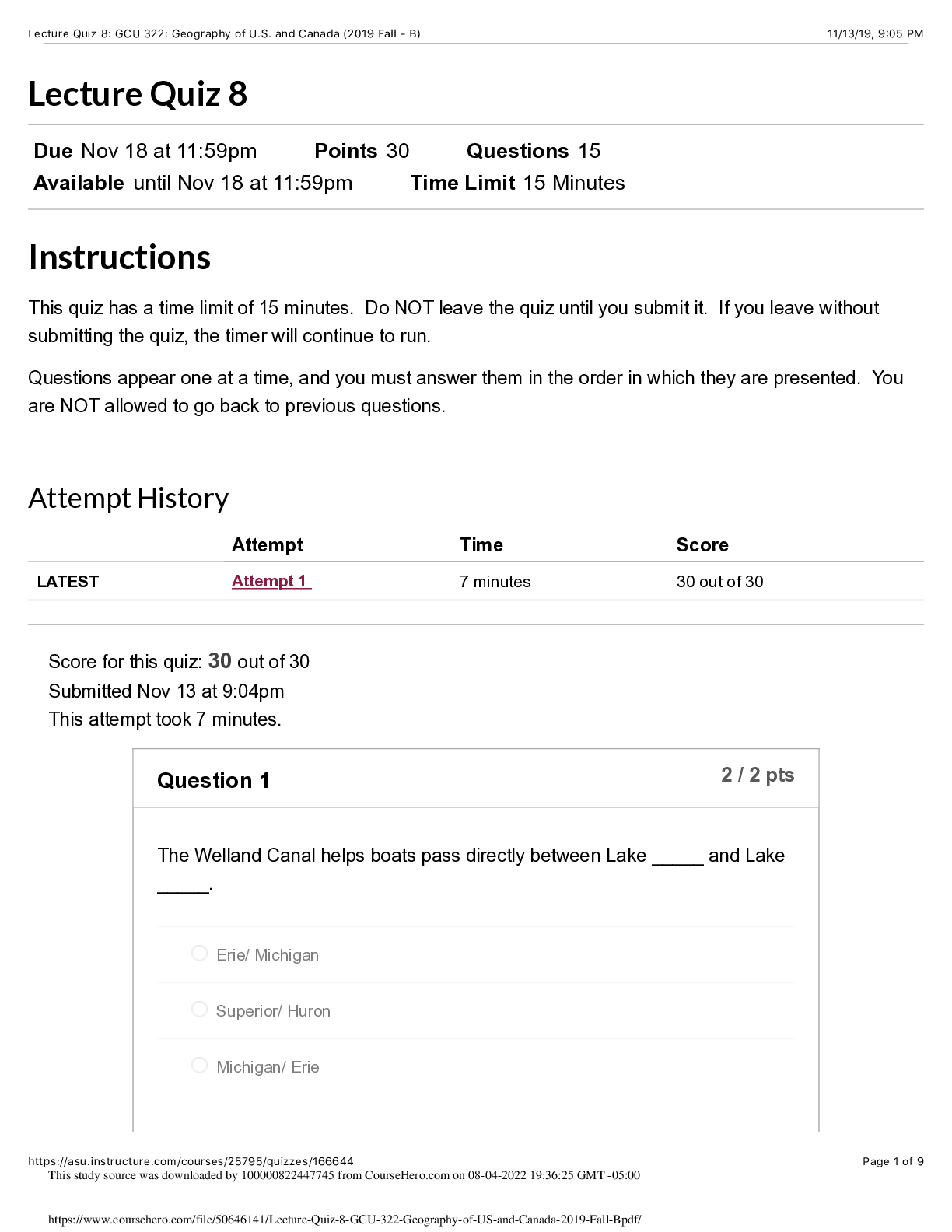
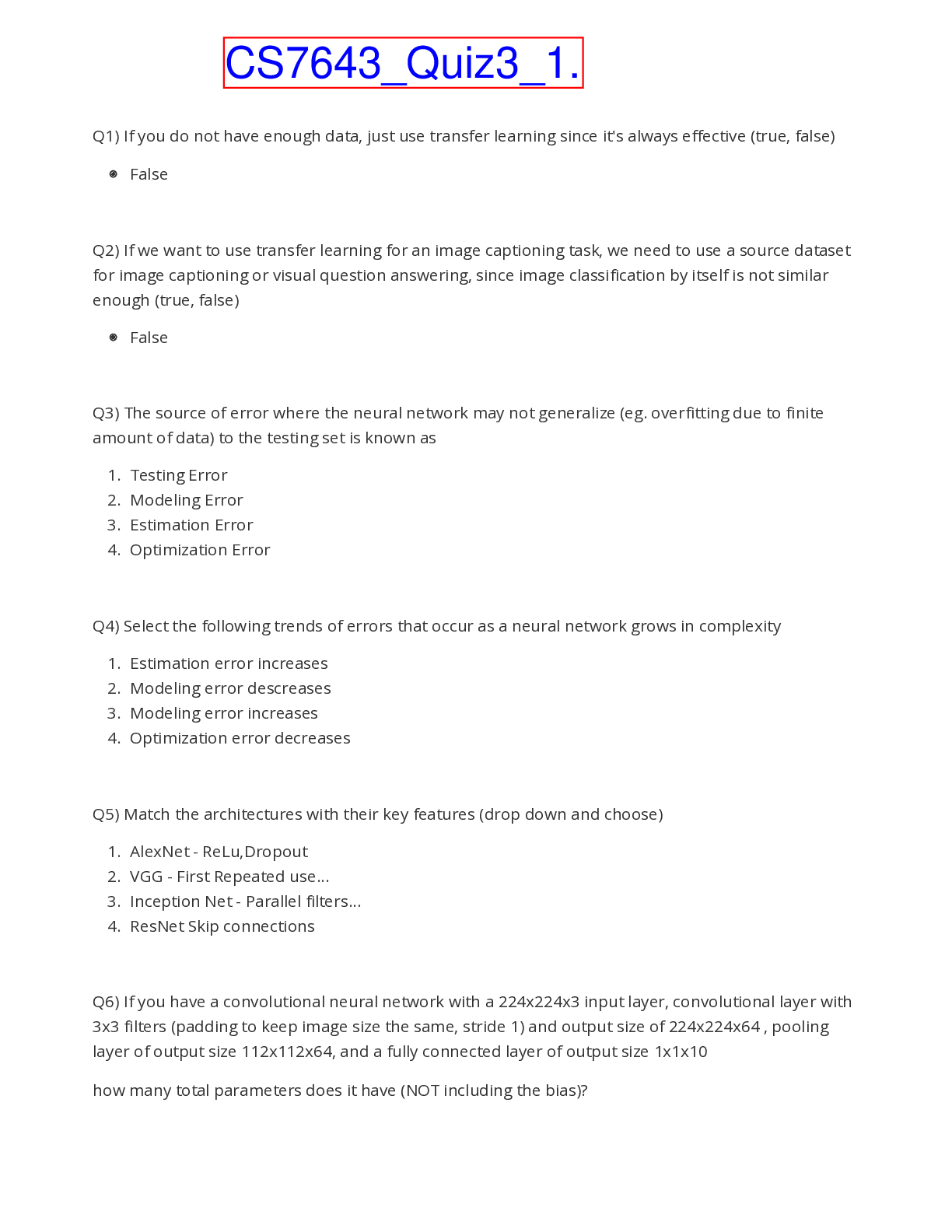

.png)
